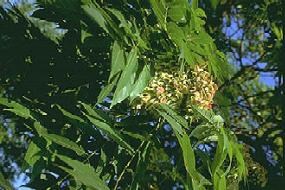
© William S. Justice. Courtesy of Smithsonian Institution
Description: Tree of heaven is an exotic, rapidly growing, deciduous tree that emits an offensive odor. The leaves are compound, one to four feet long, and can have 11 to 25 alternating leaflets along the stem. Each leaflet will have at least one glandular tooth along the base. The leaves look similar to those of black walnut and sumac. The bark along the stems is typically smooth and pale gray and along the twigs is light chestnut brown. The tree is adioecious (male or female) and blooms in late spring creating small flowers ranging in color from green to orange. The fruit produced, called samaras, is flat, papery and twisted. Tree of heaven is propagated through the seeds or root sprouts. It is a fast growing tree that can reach 80 feet in height.( Habitat: Tree of heaven occurs in 42 states ranging from Common names: Common names include Tree of heaven, China-sumac, Chinese tree of heaven, stinktree, and varnishtree (USDA ARS) Other Facts: Tree of heaven was introduced in Within Shenandoah National Park, tree of heaven is a targeted exotic plant because of its ability to rapidly grow and spread and also because it is known to produce a toxin in its leaves and bark that can inhibit the growth of other plants. It is important to the park to kill the invasive exotic species such as tree of heaven because invasive exotic species are known to be a significant threat to biodiversity. Only habitat loss is a greater threat. As an invasive exotic plant, the National Park Service attempts to remove tree of heaven from its lands. Removal is a difficult task requiring extreme diligence. Current techniques for removal include treatment with herbicides and manual removal of small trees. (Hughes, References and Links: Hughes, Jacob.2005. Further information can be found: Integrated Taxonomic Information System (ITIS) Report U.S. Department of Agriculture. Germplasm Resource Information Network database which is sponsored by the Agricultural Research Service, U.S. Department of Agriculture. PLANTS National Database, a website supported by the Natural Resource Conservation Service. |
Last updated: July 3, 2018
